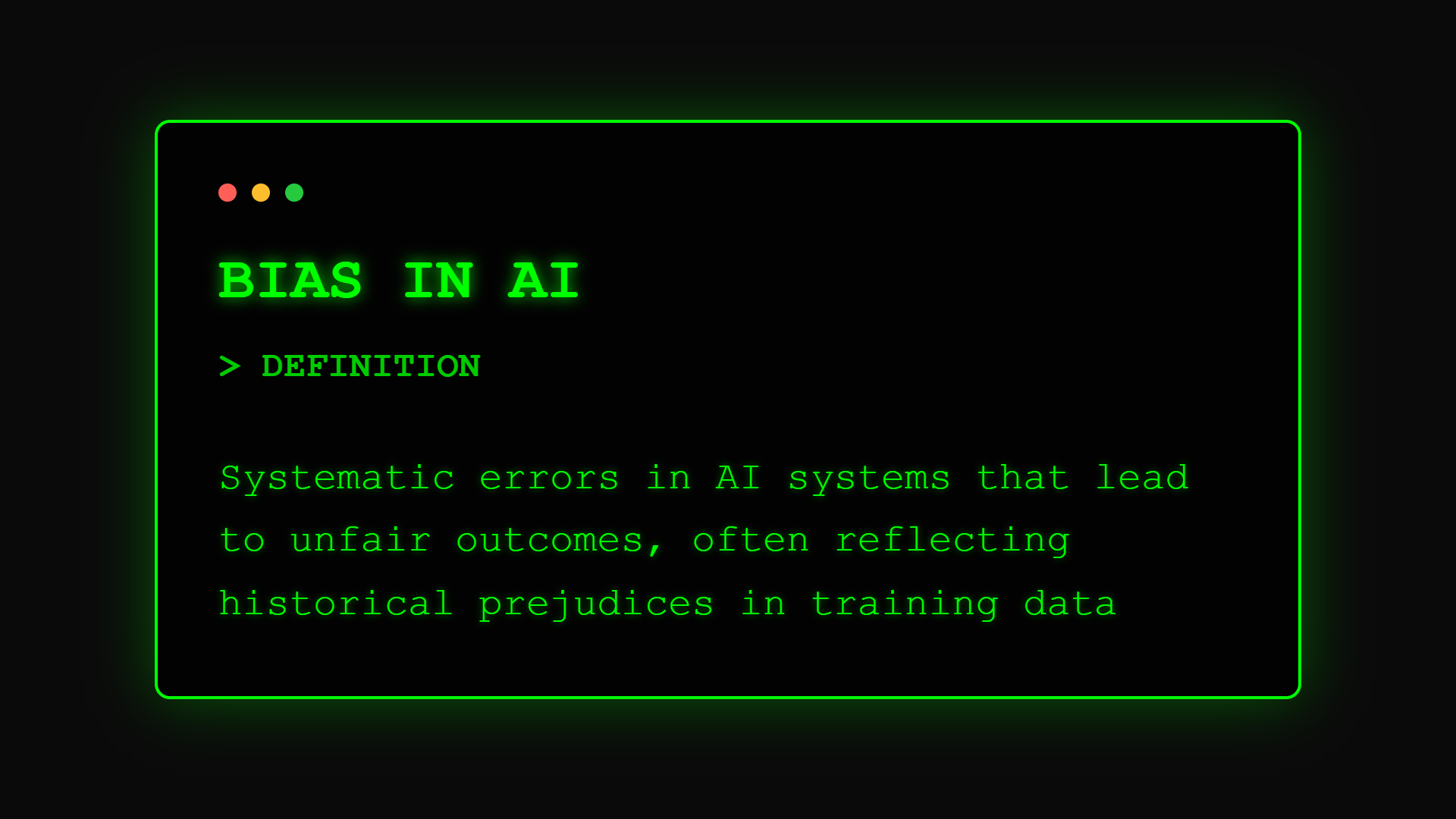AI Terms
What is Bias in AI? When Algorithms Inherit Human Prejudices

Your AI system just rejected loan applications from an entire neighborhood. Or recommended only male candidates for leadership roles. These aren't programming errors – they're AI bias in action, and they can destroy your brand reputation while creating legal liability.
Understanding AI Bias
Bias in AI occurs when machine learning systems make decisions that systematically disadvantage certain groups or individuals based on irrelevant characteristics like race, gender, age, or location. This happens not because AI is inherently prejudiced, but because it learns from biased data or flawed design choices.
According to MIT researchers, "AI bias reflects and amplifies human biases present in training data, algorithm design, and deployment contexts." Studies show that facial recognition systems have error rates up to 35% higher for darker-skinned individuals, while resume-screening AI has shown preference for male candidates.
The challenge is that AI bias often hides behind mathematical objectivity, making it harder to detect than human prejudice.
Business Impact
For business leaders, AI bias represents a triple threat: legal liability from discriminatory practices, brand damage from public backlash, and missed opportunities from excluding valuable customers or talent.
Imagine your AI as a new employee who learned everything from your company's past decisions. If those decisions contained bias – even unintentional – your AI will perpetuate and scale those biases to every decision it makes.
In practical terms, biased AI can lead to discrimination lawsuits, regulatory fines, customer boycotts, and lost market opportunities by incorrectly excluding qualified individuals or profitable segments.
Sources of AI Bias
Bias enters AI systems through multiple pathways:
• Historical Bias: Training data reflects past discrimination – like hiring data from eras with fewer women in tech reinforcing gender imbalance
• Representation Bias: Datasets that underrepresent certain groups – facial recognition trained mostly on white faces failing for others
• Measurement Bias: Using proxies that correlate with protected attributes – ZIP codes as proxy for race in lending decisions
• Aggregation Bias: One-size-fits-all models that work well on average but fail for specific subgroups
• Evaluation Bias: Testing on non-representative data that misses bias affecting excluded groups
How Bias Manifests
AI bias appears in various forms:
Allocation Bias: AI unfairly distributes opportunities or resources, like job interviews, loans, or healthcare resources
Quality-of-Service Bias: AI performs worse for certain groups, like voice assistants struggling with accents
Stereotyping Bias: AI reinforces harmful stereotypes, like translation systems assuming doctors are male
Representation Bias: AI fails to recognize or include certain groups, like image taggers not identifying darker skin tones
Each form can compound over time as biased decisions create more biased training data.
Types of Harmful Bias
Critical biases to monitor:
Type 1: Demographic Bias Affects: Protected characteristics (race, gender, age) Example: Healthcare AI undertreating pain in minorities Impact: Legal liability, healthcare disparities
Type 2: Socioeconomic Bias Affects: Income levels, education, location Example: Insurance AI overcharging low-income areas Impact: Market exclusion, reputation damage
Type 3: Behavioral Bias Affects: Personal choices and preferences Example: Hiring AI penalizing employment gaps Impact: Talent loss, discrimination claims
Type 4: Technological Bias Affects: Device or platform users Example: AI features only working on expensive phones Impact: Digital divide, customer loss
Real-World Consequences
Companies learning bias lessons the hard way:
Tech Giant Example: Amazon scrapped an AI recruiting tool in 2018 after discovering it penalized resumes containing "women's" (as in "women's chess club captain"), having learned bias from 10 years of male-dominated hiring data.
Financial Services Example: Apple Card faced investigation when its AI-powered credit decisions gave men 20x higher credit limits than women with identical finances, resulting in regulatory scrutiny and brand damage.
Healthcare Example: A major health system's AI allocated care management to healthier white patients over sicker Black patients by using healthcare costs (influenced by access disparities) as a proxy for health needs.
Detecting AI Bias
Methods to uncover hidden bias:
Statistical Testing:
- Disparate impact analysis
- Fairness metrics across groups
- Intersection testing for multiple attributes
Auditing Approaches:
- Red team testing with diverse teams
- Adversarial testing for edge cases
- Continuous monitoring in production
Transparency Tools:
- Model interpretability techniques
- Decision documentation
- Bias scorecards
Preventing and Mitigating Bias
Strategies for fair AI:
Data Level:
- Diverse, representative datasets
- Bias-aware data collection
- Synthetic data for balance
Algorithm Level:
- Fairness constraints in training
- Debiasing techniques
- Multiple model approaches
Human Level:
- Diverse development teams
- Ethics review boards
- Stakeholder involvement
Process Level:
- Regular bias audits
- Clear accountability
- Transparent documentation
Building Fair AI
Your roadmap to ethical AI:
- Start with AI Ethics principles
- Implement Explainable AI for transparency
- Establish AI Governance frameworks
- Read our Bias Prevention Playbook
Part of the [AI Terms Collection]. Last updated: 2025-01-11